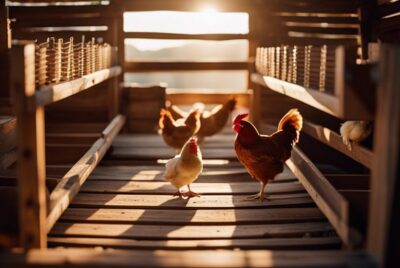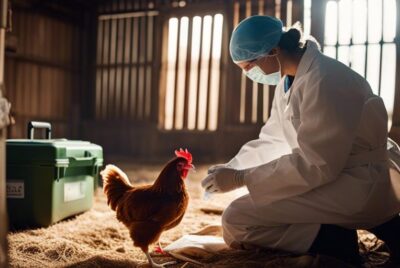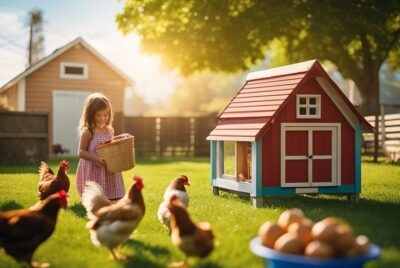Ventilation Matters – Airflow in Your Chicken Coop
There’s no denying the importance of proper ventilation and airflow in your chicken coop. Ensuring that your feathered friends have access to fresh, clean air is essential for their health and well-being. Inadequate ventilation can lead to a buildup of harmful gases, excess moisture, and an increase in ammonia levels that can all have detrimental effects on your flock. In this blog post, we will explore the significance of ventilation in chicken coops and provide helpful tips on how to improve airflow in your coop.
Understanding Chicken Coop Airflow
To ensure the health and well-being of your chickens, proper ventilation in the chicken coop is essential. Good airflow helps in regulating temperature, reducing the risk of respiratory diseases, and eliminating foul odors. Understanding the dynamics of airflow within the coop is crucial for creating a comfortable and safe environment for your feathered friends.
The Science of Air Circulation
Chicken coop ventilation involves the exchange of indoor and outdoor air, allowing fresh air to come in and stale air to be expelled. Proper ventilation helps in controlling humidity levels, ammonia build-up, and airborne pathogens. It also aids in regulating temperatures, preventing heat stress during hot weather and frostbite in colder months. By creating a consistent airflow pattern, you can maintain a healthy environment for your chickens.
Monitoring air circulation patterns inside the coop is vital to ensure that there are no stagnant areas where moisture and harmful gases can accumulate. Understanding the science behind air movement and implementing strategies to enhance airflow will contribute to a better overall living condition for your poultry.
Common Airflow Challenges in Coops
Circulation of air can be hindered by factors such as poor coop design, inadequate ventilation openings, or blockages caused by obstructions like hay or dust. Insufficient airflow can lead to a buildup of harmful gases like ammonia, which can cause respiratory issues in chickens. Additionally, high humidity levels resulting from poor ventilation can create a breeding ground for bacteria and mold, posing health risks to your flock.
Designing Your Coop for Optimal Ventilation
Even before bringing in your fluffy flock of chickens, it is crucial to ensure that your chicken coop is designed to provide optimal ventilation. Poor ventilation can lead to a build-up of toxic ammonia, excess moisture, and harmful pathogens, which can jeopardize the health and well-being of your chickens. Proper airflow is essential for maintaining a comfortable and healthy environment inside the coop.
Coop Positioning and Orientation
Coop positioning and orientation play a vital role in ensuring good ventilation. Ideally, your coop should be placed on higher ground to prevent moisture accumulation. Orient the coop so that the main openings, such as windows or vents, face away from prevailing winds to avoid drafts in the winter. Additionally, positioning the coop where it receives adequate sunlight can help naturally combat moisture and bacteria buildup.
With proper coop placement, you can take advantage of natural ventilation. Cross-ventilation can be achieved by strategically placing windows or vents on opposite sides of the coop to allow for the flow of fresh air. This constant airflow helps remove stale air and regulate the temperature inside the coop, creating a healthier environment for your chickens.
Ventilation Features and Technology
With advancements in coop design, there are various ventilation features and technologies available to enhance airflow. Consider installing adjustable vents or louvers that can be opened or closed to regulate airflow based on the weather conditions. Additionally, adding ridge vents or cupolas can promote vertical airflow, allowing hot air to escape from the top of the coop.
It is essential to strike a balance between providing adequate ventilation and protecting your chickens from drafts. Mesh screens can be added to openings to keep out predators and pests while still allowing for airflow. Investing in a combination of passive and active ventilation methods can help you tailor the ventilation system to suit your specific coop design and climate.
Maintenance of Ventilation Systems
Unlike other chores on the farm, maintaining proper ventilation in your chicken coop is crucial for the health and well-being of your flock. Proper airflow helps regulate temperature, reduce humidity, and remove harmful gases like ammonia. Neglecting ventilation maintenance can lead to respiratory issues and even death in your chickens.
Daily Ventilation Checks
One of the most important tasks in maintaining ventilation in your chicken coop is to perform daily checks. This involves inspecting all vents, windows, and fans to ensure they are unobstructed and functioning properly. Look for any signs of dust, debris, or buildup that could impede airflow. Additionally, check for any drafts or leaks that could impact the efficiency of the ventilation system.
Regularly cleaning and clearing any blockages will ensure that fresh air can flow freely throughout the coop, providing your chickens with clean, healthy air to breathe. Establishing a routine for these daily checks will help prevent ventilation issues before they become a serious problem.
Seasonal Adjustments and Cleaning
The changing seasons require adjustments to your ventilation system to accommodate temperature fluctuations and varying humidity levels. The transition from winter to summer, for example, may mean opening up more vents or windows to allow for increased airflow and cooling. Conversely, in the colder months, you may need to reduce ventilation slightly to maintain a comfortable and draft-free environment for your chickens.
A thorough cleaning of the ventilation system should also be done at least twice a year, typically in the spring and fall. Remove any accumulated dust, cobwebs, or debris from fans, vents, and air ducts to ensure optimal airflow. This maintenance not only improves air quality but also extends the life of your ventilation system, saving you money in the long run.
Health and Productivity
Impact of Ventilation on Chicken Well-being
Keep your chickens healthy and happy by ensuring proper ventilation in their coop. Good airflow helps remove excess moisture, ammonia, and other harmful gases that can build up in a confined space. Poor ventilation can lead to respiratory issues, infections, and overall stress on the birds.
For optimal well-being, make sure there is a good balance of fresh air coming in and stale air being pushed out. This will help regulate temperature, humidity, and air quality inside the coop. Proper ventilation also prevents the accumulation of dust and dander, which can cause respiratory problems in chickens.
Ventilation’s Role in Egg Production and Quality
To maximize egg production and ensure high-quality eggs, ventilation in the chicken coop is crucial. Poor air quality and high humidity levels can have a negative impact on egg production and shell quality. Adequate ventilation helps maintain a comfortable environment for the hens, which in turn can result in consistent egg laying and sturdy eggshells.
A well-ventilated coop also reduces the risk of mold growth, which can contaminate eggs and pose a health hazard to both the chickens and those consuming the eggs. Proper airflow promotes overall egg hygiene and can contribute to a higher rate of hatchability for fertilized eggs.
Summing up
Ensuring proper ventilation and airflow in your chicken coop is crucial for the health and well-being of your flock. It helps maintain air quality, regulate temperature, and prevent harmful ammonia buildup. By implementing proper ventilation systems, such as windows, vents, or fans, you can create a comfortable environment that promotes optimal chicken growth and productivity. Remember to regularly inspect and adjust your ventilation setup to meet the changing needs of your coop throughout the seasons. Maintaining good airflow in your chicken coop is a simple yet essential practice for every poultry owner to follow.



